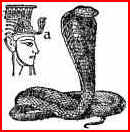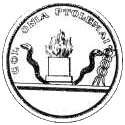Q. What is the snake-like image in the opening title sequence?
A. The snake image used in the opening title sequence of Millennium (which is biting it's own tail) is called an Ouroborus. It is the smybol of the Millennium Group. The Ouroboros lays at the edge of Pontus, the sea which surrounds the world. Surrounding the Universe, everything known and unknown is encompassed in the Ouroboros. It is first seen as early as 1600 years BC in Egypt. From there it moved to the Phonecians and then to the Greeks, who called it the Ouroboros, which means "Tail Eater". It is a symbol of the unending cycle of the universe. Some cultures see the image as a dragon rather than a snake, others as evil, or Satan.
In Chris Carter's own words: "The snake biting its own tail is called the Ouroboros. It has a lot of symbolism. It symbolizes the conflict of life devouring itself so it means both good and bad things. It's very pertinent to the show. It's a very powerful symbol, and I think appropriate to the show."
Q. Is there a connection to Dana Scully's tattoo of the Ourobouros (in The X-Files) and Millennium's use of the same symbol?
A. In The X-Files episode, Never Again, Scully had a tatoo of the Ourobouros on her hip/lower back/bottom [depending on your point of view]. According to Carter, "yes, there is an obvious connection there, it was purposeful."  The snake was associated with the Goddess of the Mediterranean who flourished around 4500 years Before the Present [BP}. Images of her and her priestesses were found in the ruins of Mycenae on Crete and Thera [today known as Santorini].
The snake was associated with the Goddess of the Mediterranean who flourished around 4500 years Before the Present [BP}. Images of her and her priestesses were found in the ruins of Mycenae on Crete and Thera [today known as Santorini].
In Kerala state in India, the goddess Manasha is still worshipped. The cobra is sacred to her, and during a week-long festival every year, cobras are captured, kept to be fed with milk in her honour and then released.
Enki [lord of stormy waters] lived with his mother Nammu [lady of abzu or sweet underground waters] in a cave in Sumer, ancient Mesopotamia. He was transformed into a flying serpent; that is, a dragon. Kingu is another Mesopotamian dragon-figure whose body was sacrificed by Marduk to form creation as a punishment for having fought on the side of Tiamat, the primeval chaos/mother also a serpentine being
In north Africa, a cosmic serpent named Minia is honoured. Her head is the sky and her tail is in the waters that are believed to lie under the earth. The Fon and Bantu peoples further to the south, believe that Mawu-Lisa formed the earth, and a creative power called Da Ayido Hwedo flows like a snake through creation. This serpent has held the earth together since that time.
In Central Africa, Chinawezi, the Rainbow King plays a similar role. He is reminiscent of the cosmic serpent known as Shesha or Ananta [Endless] upon whose coils the Hindu creator, Vishnu, rests between cycles of creation. Olokun, ruler of the sea is a central African naga king who once attempted to conquer the earth by means of the Great Flood.
The serpent also plays an important role as the creator of humankind. The Ashanti of Africa tell how the Creator Python come from the heavens and settled in the river. A couple from the heavens and a couple from the earth were introduced to each other, but neither pair could have children until the python sprayed them with water from his mouth, saying "Kus, Kus." This is what made them fertile, and able to populate the earth.
In Mexico, it was believed that Quetzalcoatl, the feathered serpent, was one of the four gods to create humanity. With his twin, Xolotl, he went to the underworld to collect the bones of a man and woman who had died in earlier, unsuccessful creations. As he tried to escape the wrath of the Lord of the Underworld, he dropped some of the bones, shattering them. The Earth Goddess ground them up with some of Quetzalcoatl's own blood which restored them, and imbued them with life.
In the Popul Vuh, the creation myth of the Quiche Maya [in Guatemala,] there also appear twin serpents with green feathers, male and female, called Xpiyacoc and Xmucane.
The feathered, plumed or flying serpent unifies qualities of heaven with those of the earth. Indigenous people of Australia honour Almudj, the Rainbow Snake a.k.a. Warnayarra whose body parts are the features of the land.
In fact, in many places the rainbow is thought of as a multi-coloured or brilliantly plumed serpent. It is this serpent that appears in conjunction with life-giving rain; the dry land comes alive with colour and the promise of plants for food.
The Pitjantjatjara and Yankunytjatjara peoples of Central Australia tell about Kuniya (Woman Carpet-python) whose story appears on Uluru [Ayers Rock]. Her myth exemplifies their mythology, the Dreamtime or Tjukurpa.
Immortality
The snake seems to be able to come back to life. It lies dull and immobile for long periods, and then in a period of an hour or so, sloughs off its dry old skin to emerge from its hiding place shining with an opalescent gleam. The Greek word geras [cf. geriatrics] denotes the cast-off skin.
Since the old skin may be sloughed off in one piece like an inside-out discarded glove, it can seem as if the old form has been left behind. This has been seen as evidence of the possibility of rebirth for other creatures, too.
Barbara Walker points out that in Melanesia, the expression that is used to refer to the Christian concept of 'eternal life' is 'to slough one's skin'. In Italian there is the phrase 'older than a serpent', and that the Chinese image used to symbolize eternal life is an old man exchanging his skin for a new one.
The Serpent as Ultimate Good
 The snake was associated with the Goddess of the Mediterranean who flourished around 4500 years Before the Present [BP}. Images of her and her priestesses were found in the ruins of Mycenae on Crete and Thera [today known as Santorini].
The snake was associated with the Goddess of the Mediterranean who flourished around 4500 years Before the Present [BP}. Images of her and her priestesses were found in the ruins of Mycenae on Crete and Thera [today known as Santorini].
In Kerala state in India, the goddess Manasha is still worshipped. The cobra is sacred to her, and during a week-long festival every year, cobras are captured, kept to be fed with milk in her honour and then released.
 The cobra with spread hood appears as part of the uraeus, a golden band worn around the brow by Egyptian kings and queens as a sign of blessing upon the throne of the Pharoah.
The cobra with spread hood appears as part of the uraeus, a golden band worn around the brow by Egyptian kings and queens as a sign of blessing upon the throne of the Pharoah.
Even after the Greek Ptolemies (including Cleopatra)  acquired that throne as a result of Roman political expedience, they kept the ancient 2-snake emblem.
acquired that throne as a result of Roman political expedience, they kept the ancient 2-snake emblem.
 This winged naga represents the life goddess, Buto or Uazet [Wadjet].
This winged naga represents the life goddess, Buto or Uazet [Wadjet].
She appears with her sister, goddess of the afterlife, on either side of the sun disc. With Nekhebet, more often depicted in her form as Vulture Goddess, the two form the  Ur-Uatchti. This emblem of Horus' victory over Set, the Adversary and Trickster god, appears as an amulet on temples.
Ur-Uatchti. This emblem of Horus' victory over Set, the Adversary and Trickster god, appears as an amulet on temples.
In the Tu'at or Underworld, one of the 4 deities associated with the 11th sector or 'hour,' is Nebt-khu. Snakes come forth daily from her feet and she lives upon their voices.
Creator-Sustainer
Enki [lord of stormy waters] lived with his mother Nammu [lady of abzu or sweet underground waters] in a cave in Sumer, ancient Mesopotamia. He was transformed into a flying serpent; that is, a dragon. Kingu is another Mesopotamian dragon-figure whose body was sacrificed by Marduk to form creation as a punishment for having fought on the side of Tiamat, the primeval chaos/mother also a serpentine being.
The Romans brought from Syria, a goddess (Dea Syria) whom they called Artagatis. She is depicted as a woman in her 60's at attention, immobile as a tree, with a python balanced on its tail twined once around her, its head at her heart looking at her face.
Rainbow and Cosmic Serpents
In north Africa, a cosmic serpent named Minia is honoured. Her head is the sky and her tail is in the waters that are believed to lie under the earth. The Fon and Bantu peoples further to the south, believe that Mawu-Lisa formed the earth, and a creative power called Da Ayido Hwedo flows like a snake through creation. This serpent has held the earth together since that time.
In Central Africa, Chinawezi, the Rainbow King plays a similar role. He is reminiscent of the cosmic serpent known as Shesha or Ananta [Endless] upon whose coils the Hindu creator, Vishnu, rests between cycles of creation. Olokun, ruler of the sea is a central African naga king who once attempted to conquer the earth by means of the Great Flood.
The serpent also plays an important role as the creator of humankind. The Ashanti of Africa tell how the Creator Python come from the heavens and settled in the river. A couple from the heavens and a couple from the earth were introduced to each other, but neither pair could have children until the python sprayed them with water from his mouth, saying "Kus, Kus." This is what made them fertile, and able to populate the earth.
In Mexico, it was believed that Quetzalcoatl, the feathered serpent, was one of the four gods to create humanity. With his twin, Xolotl, he went to the underworld to collect the bones of a man and woman who had died in earlier, unsuccessful creations. As he tried to escape the wrath of the Lord of the Underworld, he dropped some of the bones, shattering them. The Earth Goddess ground them up with some of Quetzalcoatl's own blood which restored them, and imbued them with life.
In the Popul Vuh, the creation myth of the Quiche Maya [in Guatemala,] there also appear twin serpents with green feathers, male and female, called Xpiyacoc and Xmucane.
The feathered, plumed or flying serpent unifies qualities of heaven with those of the earth. Indigenous people of Australia honour Almudj, the Rainbow Snake a.k.a. Warnayarra whose body parts are the features of the land.
In fact, in many places the rainbow is thought of as a multi-coloured or brilliantly plumed serpent. It is this serpent that appears in conjunction with life-giving rain; the dry land comes alive with colour and the promise of plants for food.
The Pitjantjatjara and Yankunytjatjara peoples of Central Australia tell about Kuniya (Woman Carpet-python) whose story appears on Uluru [Ayers Rock]. Her myth exemplifies their mythology, the Dreamtime or Tjukurpa.
Immortality
The snake seems to be able to come back to life. It lies dull and immobile for long periods, and then in a period of an hour or so, sloughs off its dry old skin to emerge from its hiding place shining with an opalescent gleam. The Greek word geras [cf. geriatrics] denotes the cast-off skin.
Since the old skin may be sloughed off in one piece like an inside-out discarded glove, it can seem as if the old form has been left behind. This has been seen as evidence of the possibility of rebirth for other creatures, too.
Barbara Walker points out that in Melanesia, the expression that is used to refer to the Christian concept of 'eternal life' is 'to slough one's skin'. In Italian there is the phrase 'older than a serpent', and that the Chinese image used to symbolize eternal life is an old man exchanging his skin for a new one.
Sexuality
The Pelasgian Great Goddess, Euronyme, danced with the Wind to produce Ophion who mated with Her to produce the World Egg.
In the South-west of North America, the pregnant belly of the earth is thought by aboriginal people to be the site called Great Serpent Mound.
The serpent is associated with sexuality only partly because of its obvious resemblance to the male organ of reproduction. Classical mythology recounts how the Tiresias, the prophet who had predicted the misfortunes of the family of Oedipus [who killed his father and went on, unknowingly to marry his mother, Jocasta], was himself a victim of the god's capriciousness.
As a young man, Tiresias was going through the woods one day when he happened upon two snakes winding around each other in the process of copulating. He was startled and blindly struck both of them with his walking stick and instantaneously, he was transformed into a woman. He experienced life as a female for the next 7 years.
In the 8th year, he came upon the two serpents once again. This time without emotion, he struck them intentionally. And was returned to his former state. However, he soon annoyed the Queen of Heaven, Juno [Gr.: Hera], by revealing to her husband Jove [Zeus] the fact that women derive more pleasure from the sexual act than men. He was cursed with blindness for the rest of his days.
The actions of Tiresias are preserved in the form of the caduceus that Hermes [Latin: Mercury] carries as he leads the dead to the Underworld.  There are the two snakes twined around the moving staff. It should not be surprising to find that this emblem also embodies the twin channels as they wind up the chakras of the body with the spine the central rod terminates in the spherical head.
There are the two snakes twined around the moving staff. It should not be surprising to find that this emblem also embodies the twin channels as they wind up the chakras of the body with the spine the central rod terminates in the spherical head.
On the 3-sided blade of a Tibetan Buddhist phurba [pron. p'urba] sometimes referred to as a spirit dagger or spirit nail, we again see the pair of interwined snakes.
Harmonia, wife of Cadmus (who slayed the dragon of Ares and founded Thebes) received as a wedding gift from Aphrodite, a special necklace. This Golden Necklace was in the form of an amphisbaina -- a two- headed serpent with open mouths clasping in their jaws a golden eagle, whose wings were decorated in yellow jasper and moonstone. Over many generations, the necklace (with an accompanying robe) was the source of terrible conflict.
At Echmiadzin, the religious center of the Armenian Apostolic Church, there is a priest's staff decorated the heads of two serpents or dragons. There is also a type of Armenian carpet called vishapagor which depicts one or more serpents, or makes use of a serpent motif. ~ Anahit:Visit Armenia
Outside certain Hindu temples, mainly in south India, small sculptures in various forms of serpents are set up at the foot of sacred trees. Many of these snake stones depict the familiar braided form of two copulating snakes which has come down to us as the emblem of the medical profession. These rupas [images] are offered in gratitude by couples whose wish for children, especially sons, has been granted by the deities to whom the snake
 Free Forum Hosting
Free Forum Hosting